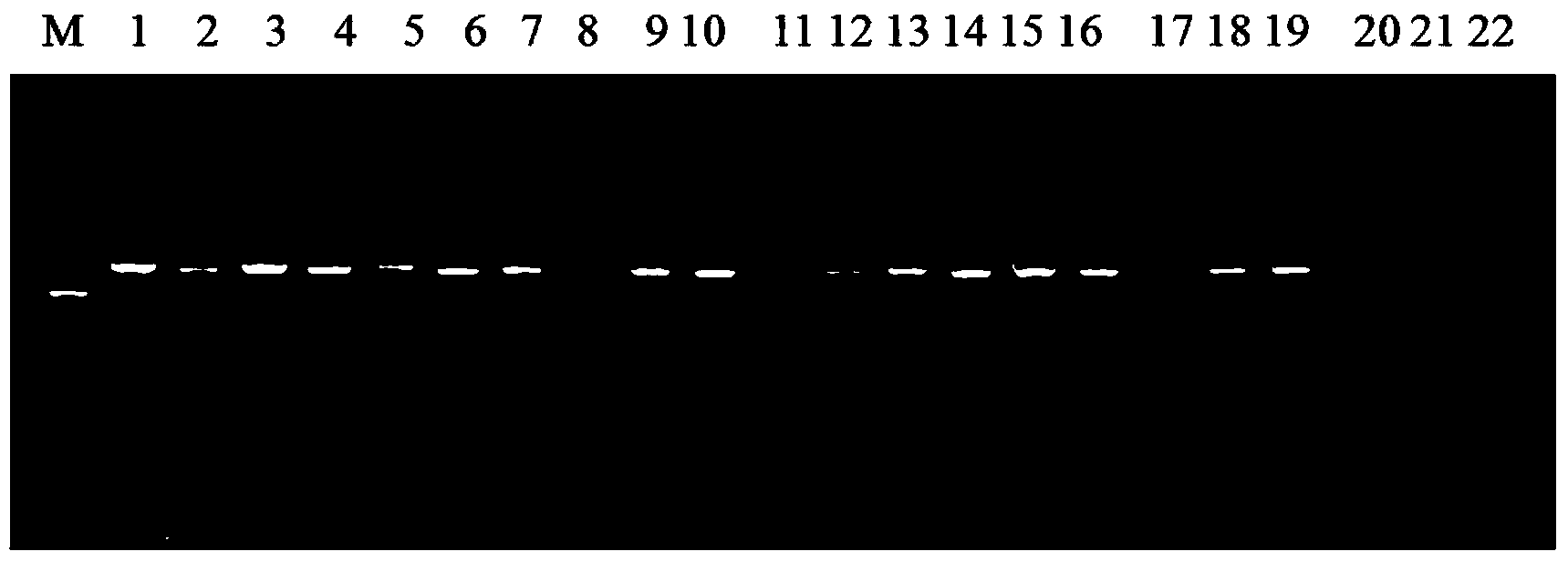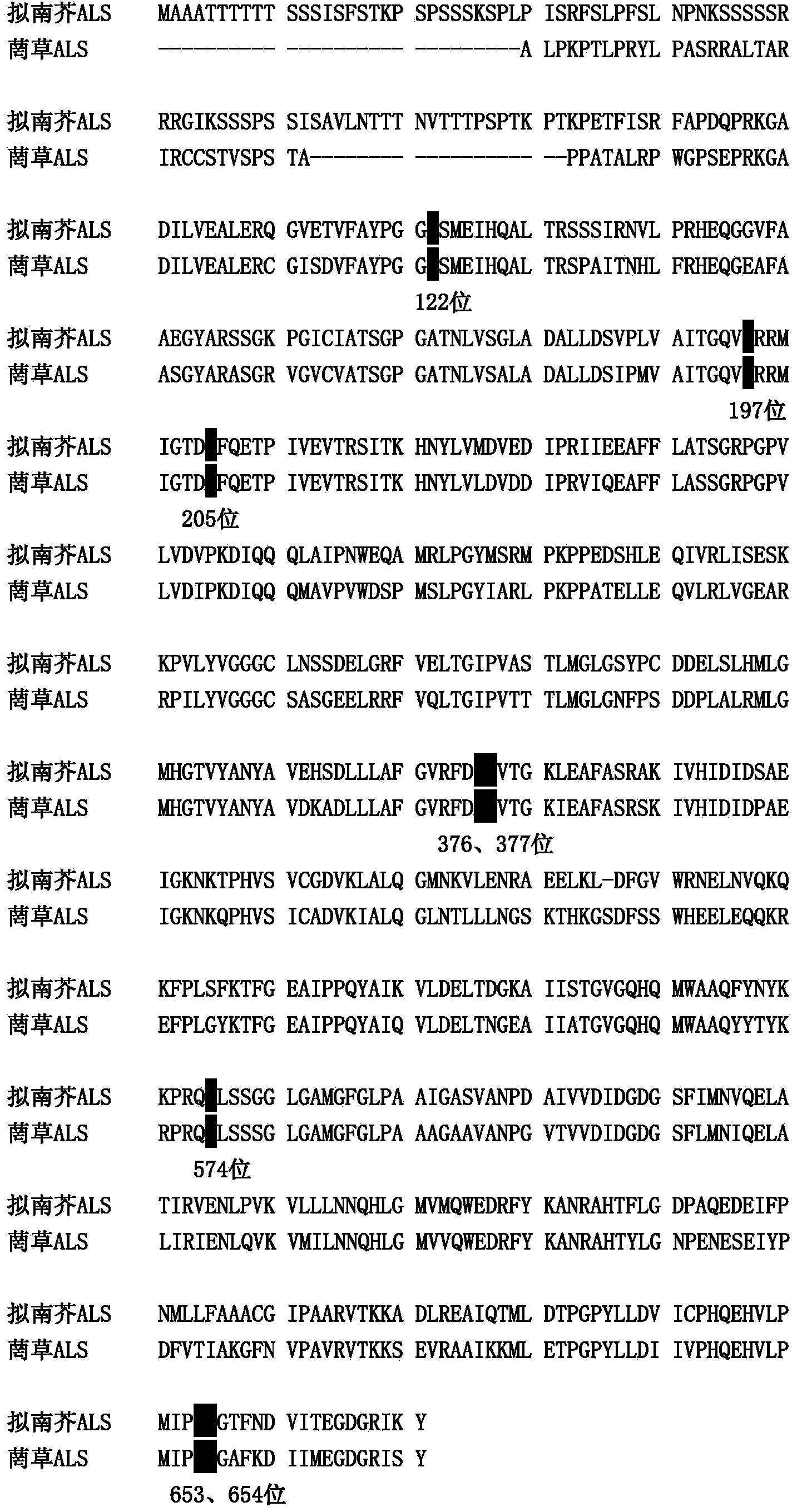Polymerase chain reaction (PCR) detection method and kit for anti-amyotrophic lateral sclerosis (ALS) inhibitor herbicide beckmannia syzigachne
A technology of herbicides and inhibitors, which is applied in the field of PCR detection methods and kits for anti-ALS inhibitor herbicides, can solve the problems of not being able to detect in the current season, heavy workload, and large land occupation, and meet the requirements of fast Diagnosis, practical effect
- Summary
- Abstract
- Description
- Claims
- Application Information
AI Technical Summary
Problems solved by technology
Method used
Image
Examples
Embodiment 1
[0035] Example 1 is used to detect the synthesis of the PCR primers of anti-ALS inhibitor class herbicide Smilax
[0036]According to the ALS gene sequence of Alopecurus (Apera spica-venti (GenBank: JN646110.1), Alopecurus aequalis (GenBank: JQ743908.1) and Alopecurus aequalis (GenBank: JQ743908.1) The primers were designed for the conserved region of the ALS gene sequence in ), and obtained by segmental amplification, the nucleotide sequence is shown in Seq ID No.5), and the specific primer pair WC-ALS-IF / WC-ALS-IR and WC -ALS-ⅡF / WC-ALS-IIR is used to specifically amplify the ALS gene of Sagegrass, and the relative position of each primer on the ALS gene of Smilax is shown in figure 1 , the ALS fragment amplified by these two pairs of primers contains all 8 SNP sites currently found in other plants resistant to ALS inhibitor herbicides ( image 3 and Figure 4 ). The primer sequences are as follows:
[0037] Forward primer WC-ALS-IF: 5'-CGCCTTACCCAAACCTACT-3'(Seq ID No.1)...
Embodiment 2
[0042] Example 2 The PCR detection method of the anti-ALS inhibitor herbicide Smilax
[0043] Experimental material: Herbs with resistance and sensitivity.
[0044] experimental method:
[0045] 1. The preparation of the DNA of Saffron
[0046] Take 200 mg of fresh leaves of Smilax, grind with liquid nitrogen, and extract the DNA of each Smilax leaf by conventional CTAB method.
[0047] 2. Specific primers for detecting the ALS mutation site in Smilax chinensis, see Example 1 for the primer sequence.
[0048] 3. PCR reaction system for detection of ALS mutation site in Smilax
[0049] PCR reaction system, in which 10×PCR reaction buffer 2μL, 15mM MgCl 2 0.5 μL, 1 μL of 2.5 mM dNTPs, 0.5 μL each of 10 μM forward and reverse primers, 1 U of Taq DNA polymerase, 1 μL of DNA template, and sterilized double distilled water for the rest, the final volume is 20 μL.
[0050] 4. PCR amplification program for detecting the ALS mutation site in Smilax
[0051] Pre-denaturation at 94...
Embodiment 3
[0058] Embodiment 3PCR method detects the field anti-ALS inhibitor's Smilax
[0059] The detection method is as follows:
[0060] 1. Sample collection and DNA preparation
[0061] In order to verify the feasibility of the PCR detection method, we collected the Smilax plants in the farmland where resistance was suspected to occur, and after proper moisturizing treatment, they were mailed to the laboratory. Take 200 mg of fresh leaves of Smilax, grind with liquid nitrogen, and extract the DNA of each Smilax leaf by conventional CTAB method.
[0062] 2. Specific primers for detecting the ALS mutation site in Smilax chinensis, see Example 1 for the primer sequence.
[0063] 3. PCR reaction system for detection of ALS mutation site in Smilax
[0064] With embodiment 2.
[0065] 4. PCR amplification program for detecting the ALS mutation site in Smilax
[0066] With embodiment 2.
[0067] 5. Identification of PCR products
[0068] With embodiment 2.
[0069] 6. PCR product s...
PUM
 Login to View More
Login to View More Abstract
Description
Claims
Application Information
 Login to View More
Login to View More - R&D
- Intellectual Property
- Life Sciences
- Materials
- Tech Scout
- Unparalleled Data Quality
- Higher Quality Content
- 60% Fewer Hallucinations
Browse by: Latest US Patents, China's latest patents, Technical Efficacy Thesaurus, Application Domain, Technology Topic, Popular Technical Reports.
© 2025 PatSnap. All rights reserved.Legal|Privacy policy|Modern Slavery Act Transparency Statement|Sitemap|About US| Contact US: help@patsnap.com



